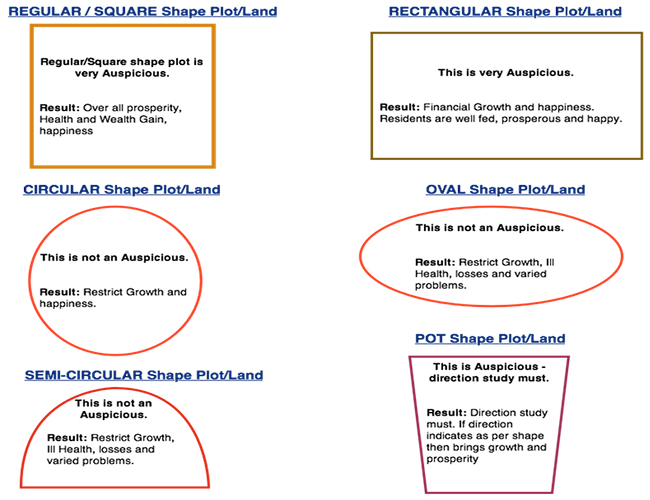
Selecting the right plot is crucial because it serves as the foundation of your home or office, radiating both positive and negative energies depending on factors such as location, orientation, shape, slope, and soil quality. When choosing a plot, it's essential to consider five key factors. Unfortunately, many people overlook consulting a **Vaastu Expert** when purchasing a plot, but involving one can offer valuable insights that ensure the site aligns with Vaastu principles. As a Vaastu Expert, I strongly recommend seeking expert advice during the plot selection phase. A Vaastu consultant can help identify aspects that will not only comply with Vaastu Shastra but also promote harmony and well-being in the future. If you already own a plot, it's never too late to evaluate it based on Vaastu guidelines to ensure it meets the criteria for positive energy flow. The following Vaastu Guidelines should be carefully considered when selecting a plot, as many of these are grounded in both scientific reasoning and practical common sense.

Vaastu Shastra offers clear and practical guidelines for selecting a plot, each backed by scientific logic and reasoning. Since Vaastu is a science, every principle serves a purpose aimed at promoting balance and harmony. As a **Vaastu Expert**, I have endeavored to explain these guidelines in a rational and scientific way, so you can make informed decisions. Ultimately, it’s your choice which guidelines you wish to follow, but understanding the reasoning behind them will help you appreciate their significance and the benefits they offer.
A peaceful, calm location with plenty of greenery and a reliable water source is ideal for many reasons. Fertile soil not only supports plant life but also indicates the quality of the land for construction purposes. Good soil is essential for a strong foundation, ensuring stability and longevity for any structure built on it.
When buying a piece of land, it's wise to stand on the property and sense its vibrations for a few moments. If the land gives you a positive feeling, it may be a good fit for you. If you feel uneasy or uncomfortable, it’s likely not the right choice. This approach emphasizes trusting your instincts, but it’s important to ensure that your judgment is free from external influences, allowing you to make a decision that aligns with your true feelings and intentions.
It's important to check the history of a plot before purchasing. Ideally, the land should have a positive past, where happy and successful people have lived. The reasoning behind this is psychological—knowing that the previous inhabitants were prosperous can create a sense of good energy and positive vibes. Additionally, consider the roads surrounding the plot. A plot with pathways on all four sides is highly favorable, as it is believed to bring health, wealth, prosperity, and happiness. The reasoning behind this is practical: such a plot is not bordered by any other properties, allowing for optimal lighting and ventilation from all directions. If a plot with roads on all four sides isn't available, the next best choice is one with roads on the North or East sides. This ensures more light and fresh air can enter the property in the mornings, promoting a brighter and healthier environment.
It’s best to avoid purchasing a plot where there is a history of a haunted or dilapidated house. Additionally, plots where recent tragic events, such as suicides or multiple deaths within a short span, have occurred should also be avoided. Such knowledge could cause psychological unease, making it hard to feel comfortable in the space. Similarly, avoid buying a plot that has been sold under stress or financial duress. Knowing the previous owner sold the land out of desperation can lead to feelings of guilt or discomfort. If considering such a purchase, it’s wise to proceed with caution and seek proper advice from a **Vaastu Expert** to ensure peace of mind.
It is advisable to steer clear of plots located near public places or buildings, such as temples, hospitals, factories, schools, or colleges. These areas tend to be crowded and noisy, which can disrupt your peace. However, if a plot is situated at least 80 to 100 feet away from such locations, it may be considered acceptable. Additionally, avoid plots near sources of unpleasant odors. Being close to establishments like meat shops, workshops, leather tanneries, laundries, shoe shops, dustbins, or sewage drains can lead to persistent foul smells that permeate your home, creating an unsuitable living environment. Plots situated between larger properties should also be approached with caution. In these cases, the owner of the smaller plot may feel inferior due to their ability to build a significantly smaller house compared to their larger neighbors, potentially leading to feelings of inadequacy. Choosing a plot with careful consideration of these factors will help ensure a harmonious living space.
It's wise to avoid plots that have numerous cracks or overly wet soil. Cracks typically indicate dried clayey soil, while excessively wet soil suggests poor drainage, both of which are unsuitable for building foundations. Such soil retains moisture, leading to increased costs for waterproofing the foundation. Additionally, steer clear of plots located at T or Y intersections of roads. These locations can expose you to oncoming traffic, potentially creating feelings of nervousness and a lack of privacy. However, there are certain situations where plots in these positions may still be acceptable, depending on other favorable factors in their environment. Always assess the overall context before making a decision.
Plots that face a T or Y intersection, where roads converge directly in front of the property from various directions, are termed **Veethi Shool** (road arrows). Due to the complex variations of road layouts, directions, and incoming traffic, it’s challenging to categorize these intersections universally. Therefore, we will explore the fundamental criteria for evaluating them as favorable, unfavorable, detrimental, or extremely detrimental.
If your plot is situated at an intersection (known as Veethi Shool), the visibility of oncoming traffic and pedestrians may induce feelings of nervousness or a lack of privacy. To address this, consider utilizing the corner of the plot that faces the intersection for a purpose such as a garage or car porch, thereby keeping the main house away from direct exposure to the intersection. Alternatively, you can fence off that area and transform it into a garden or outhouse to enhance privacy.
According to Vaastu Shastra, the shape of a plot significantly influences the well-being of its inhabitants. Research indicates that certain plot shapes can have positive effects, while others can be detrimental. Additionally, some plots can be modified to achieve a more favorable shape. Since Vaastu is a science, there is logical reasoning behind each guideline. As a Vaastu Expert, I have endeavored to present these principles in a rational and scientific manner, allowing you to determine which aspects to adopt or disregard.
Square plot - A plot with equal length and width is regarded as the ideal site for construction. According to Vaastu principles, such dimensions promote holistic growth, prosperity, and happiness. Historically, houses were designed around a central square courtyard to enhance ventilation, making square plots highly suitable for residential purposes.
Rectangle plot - A plot with a length-to-width ratio of 1:2 is considered favorable. If the length is oriented to the north and the width to the west, it is deemed even more suitable. Such plots are believed to promote good health, wealth, and prosperity for the inhabitants. Similar to square plots, they facilitate the design of a square or rectangular house, allowing any extra space to be utilized for trees, outhouses, or other purposes, ensuring that no area goes to waste..
Triangular plot - Triangle-shaped plots are deemed unfavorable. Such sites are often associated with a constant fear of fire hazards.
Circular/Elliptical/Oval Plots - These shapes are not regarded as suitable for constructing houses. According to Vaastu principles, such plots are believed to bring misfortune to their owners.
Plots With more than 4 sides -
Plots With more than 4 sides - Pentagon, hexagon, and octagon-shaped plots should be avoided for house construction. Residents of such plots often experience a sense of fear and unease.
Gou-mukhi plot -A plot that is narrow in the front and wider at the back is referred to as Gou Mukhi. Such plots are considered auspicious for residential purposes and are believed to bring prosperity to the homeowners.
Simha-mukhi plot - A plot that is wide at the front or entrance and narrow at the back is known as a Simha Mukhi plot. While these plots are considered inauspicious for residential purposes, they are deemed suitable for commercial use.
Plots with corners cut -Plots with missing corners should be avoided for any reason. If purchasing such a plot is unavoidable, it is essential to consult an Expert Vaastu Shastri. Plots with cut corners are generally regarded as inauspicious.
Plots with projections or extensions -Plots with extensions in the North, East, or North-East are viewed as favorable. In contrast, extensions in the North-West, South-East, or South-West are deemed inauspicious and are believed to bring misfortune to the owners.
Vaastu Shastra provides guidelines to help you choose a plot with the optimal direction. Being a science, every guideline is backed by logic and reasoning. As a Vaastu Expert, I have made an effort to present these guidelines in a rational and scientific manner, allowing you to determine which ones to follow.
In the ancient texts of Vaastu, guidelines for selecting a plot with the ideal orientation are rooted in common sense, scientific reasoning, and logic. According to Vaastu, all directions have their unique advantages and are considered good. The reasoning behind this is simple: in any city or town, roads extend in all four directions, naturally requiring houses on both sides to create an aesthetic environment. Consequently, every plot is deemed beneficial. An east-facing plot is favorable for scholars, philosophers, priests, professors, and teachers, as the morning sun is seen as a source of enlightenment. A north-facing plot suits those in power, administration, and government roles. South-facing plots benefit business professionals and those in management positions. Conversely, west-facing plots are more appropriate for individuals providing support services to society. Vaastu associates each direction with different social classes based on their occupations in ancient Indian society. Over time, these classes evolved into castes, leading to reduced social interaction among them, resulting in homes being clustered according to caste.
In ancient Vaastu texts, specific guidelines are provided to assist in selecting a plot or site with the ideal soil type. Since Vaastu is a science, each guideline is backed by logic and reasoning. As a Vaastu expert, I aim to present these guidelines in a rational and scientific manner, allowing you to make informed decisions about what to follow and what to disregard..
To build any structure, a plot of land is essential, ensuring that it hasn't been previously allocated for other purposes. It's crucial to consider the land's prior use. Ideally, the best land for construction is one that is suitable for cultivation, where vegetation can thrive. Various soil types can be identified by their colors, including brick red, dark brown, white, red, yellow, and black. Typically, soils that are conducive to farming, such as red, brick red, brown, and yellow, are also suitable for building foundations. Conversely, black and clayey soils, which are not ideal for agriculture, are also unsuitable for construction due to their water retention properties, which can lead to foundation dampness. Therefore, it is advisable to avoid sites with black or clayey soil. The reason for this recommendation is that black soil tends to retain water and lacks proper drainage, necessitating a specialized foundation and waterproofing, significantly increasing costs. Additionally, rocky terrain should also be avoided for construction. Land filled with rocks and thorny vegetation may indicate underlying rock that would require blasting, leading to unexpected expenses. Furthermore, plots with a high number of worms should be steered clear of, as this may suggest loose soil that won't adequately support a foundation.